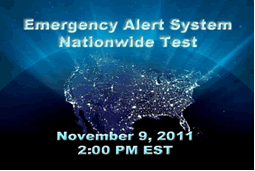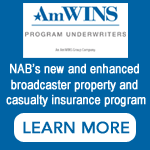
|
23 Days Until the National EAS Test
All stations are responsible for ensuring that EAS encoders and decoders are installed and configured so that the monitoring and transmitting functions are available during the times that the station is in operation. FEMA has assembled a set of EAS Best Practices by which EAS Participants may check to see if they are maintaining their EAS equipment in good working order. These best practices may be found on FEMA's National EAS test website. EAS Test
- Mandatory Reporting The FCC has established an on-line EAS National Test Reporting System. This electronic submission system should impose a lesser burden on EAS Participants because they will be able to input electronically the above information. The FCC has indicated that all information collected will be kept confidential. The FCC is expected to announce that link for the on-line system within the next week. Public
Outreach
Detailed information about the National EAS test, including TV and Radio PSAs and links to FCC, FEMA and other organizations websites, is available here. Check back frequently for updates. |
|
Last
Call for Proposals for the The 2012 NAB
Show will host the 66th NAB Broadcast Engineering Conference.
This world-class conference addresses the most recent developments
in broadcast technology and focuses on the opportunities and challenges
that face broadcast engineering professionals. Each year hundreds
of broadcast professionals from around the world attend the conference.
They include practicing broadcast engineers and technicians, engineering
consultants, contract engineers, broadcast equipment manufacturers,
distributors, R&D engineers plus anyone specifically interested
in the latest broadcast technologies. VSB Measurements Seminar plus 8VSB Specialist Certification Exam Review Friday, October
28 2011 6:00 - 9:00 p.m. (Exam Review) This
updated seminar presented by Gary Sgrignoli of Meintel, Sgrignoli
and Wallace will help you develop an understanding of the 8-VSB
transmission system basics as well as measurement techniques.
Practical test equipment information will be covered. Also included
is new information on mobile/handheld DTV, distributed transmission
and recent information on DTV reception. The seminar
is designed for broadcasters, consultants, equipment manufacturers
(broadcast, consumer, and test), translator/LPTV operators and
cable operators. Friday's special SBE 8-VSB specialist certification
exam review session is free. If you have questions, contact Tim
Schuessler, (972) 313-1333 or Gay
Sgrignoli, (847) 259-3352. The October 17, 2011 TV TechCheck is also available in an Adobe Acrobat file. Please click here to read the Adobe Acrobat version of TV TechCheck. |
ADVERTISEMENTS
 There
are only 23 days left to the first-ever, coordinated, end-to-end
test of the nationwide Emergency Alert System (EAS) on November
9, 2011. By FCC rule, all Radio and Television stations, including
Non-participating National stations (NN), must participate in the
November 9 National test. Here's what you need to know:
There
are only 23 days left to the first-ever, coordinated, end-to-end
test of the nationwide Emergency Alert System (EAS) on November
9, 2011. By FCC rule, all Radio and Television stations, including
Non-participating National stations (NN), must participate in the
November 9 National test. Here's what you need to know:

